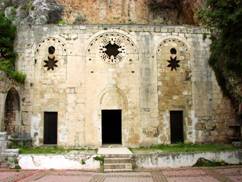
GROTTO OF ST. PETER IN ANTIOCH
There is no documentary evidence of the origins of the cave, but we have the findings of two famous archaeologists who visited the cave in October 2004, Fr Pasquale Castellana, who is an expert on ancient Roman roads in Syria, and Fr Michele Picirillo who carried out excavations on Mt Nebo in Jordan
These specialists were astonished at the richness of the symbols (niches and openings) which can be seen in the rock surrounding the Cave of St Peter. These, they declared, were not made by nature but were expressions of religious feelings.
The first Christians saw these symbols not as expressions of idolatry, but as manifestations of the religious feeling of their ancestors.
Clearly this was a site of pagan worship which the Christians, rather than destroying, later transformed into a site of their own religion, and assigned it the name of an Apostle.
Naturally, this religious transformation must date from the time when this became possible, namely when the Emperor Theodosius the Great, in the Edict of Thessalonica, proclaimed Christianity the state religion.
Michele Picirillo believes although the mosaics on the floor of the Cave are certainly Byzantine, they were not made for the Cave since they lack continuity of design, and are in fact separate pieces taken from different places and assembled there.
It would be fair to conclude that the mountain was a sacred place for the city, dedicated to some pagan god.
There were two aqueducts fed from the streams that ran down to the thermal pools which were below and to the right of the small incline which leads to the Cave.
It is also probable that it was in the time of Theodosius the Great that this pagan site was transformed into a place of Christian worship. History tells us in fact that from 388 AD onward any places of pagan worship which were not destroyed were turned into places of Christian worship as if they were ‘baptised’.
None of this takes away from the spiritual and historic value of this place, which brings us from the fourth century of our era down to the latest Byzantine period. Of the very earliest building, there remain some traces of frescoes from the right side of the altar, frescoes which would formerly have entirely covered the surrounding of the altar’s base.
Above the small esplanade which covers the site of an ancient Christian cemetery, rises the façade built in the last century in the oriental style. Three doors open into the cave where traces of the ancient mosaic floor can still be seen. At the back there is a niche which since 1932 has contained a white marble statue of St. Peter. In 1990 a stone throne was placed behind the altar.
At the back of the cave, to the left, there is a tunnel, which used to be an escape route in case of unexpected attack. To the right there is a small spring which flows from the rock. The water is collected in a small basin, which could also be used as a font.
Around 1580 the Moslems gave the cave to the Orthodox who used it, up until the middle of the last century, as a place of worship and a cemetery.
In 1856 the cave came into the possession of the French consul at Aleppo. He presented it to the Holy See through the Apostolic Delegate in Syria, Mgr Brunoni, who gave it into the keeping of the Capuchins that they represents the Catholic Church in Antioch since 1846.
Today it is possible to celebrate mass in the grotto, maybe the first Cathedral of the World, whenever a group of pilgrims requests it.
Concerning the origins of the Grotto of St Peter in Antioch
By Father Domenico Bertogli, parish priest of the Catholic church in Antioch
On 5 October 2005, together with the world-renowned archaeologists Father Michele Piccirillo and his assistant Father Carmelo (excavators of Mount Nebo in Jordan) and Father Pasquale Castellana from Aleppo, I visited the Grotto of St Peter and the surrounding mountain as far as the so-called Iron Gate (beside the grotto). It was an opportunity to reconsider in a serious manner the subject of Christian worship in this place, which certainly reminds us of the beginnings of the church.
Nowadays we keep on repeating: 'Formed out of a natural hollow in the rock on the west slope of Mt Stauris, the grotto is 13m long, 9m wide and a little more than 7m high. Here, according to tradition, the early Christian community met with Barnabas, Paul and Peter, who stayed in Antioch for several years (42-48), before going to Rome. Tradition specifies that it was given to the church by Luke, a native of Antioch, later to become the Evangelist St Luke. The Crusaders, who conquered Antioch on 3 June 1098, extended the grotto by a few metres and built the two arches that link it to the façade.
Traces of floor mosaic still remain from the original construction, and also some almost invisible frescos on the right side of the altar - frescos which once probably covered the entire back wall. Now the above-mentioned archaeologists told me that they were 'amazed at the richness of symbols on the rock which crowns the Grotto of St Peter'; and Father Pasquale added the following:
' I have no doubt at all about the conviction that these people in antiquity left on the rocks expressions of their beliefs. These symbols confirm the path of the religious story. Whatever was good in the feelings of the ancient population, our fathers gave value to it, adopting it in a way that was far from idolatry. Was it a holy place? So they could choose it for their religious meetings.
|
|
|
Interior of the grotto |
Bas-relief of Caron
(near the Grotto)
|
Map |
I repeat that there is no doubt about the existence of the religious symbols. These were not made either from natural causes, or arbitrarily from a simple pleasure in drawing these signs. They are expressions of piety. Afterwards the first Christians adopted them not as expressions of idolatry, but as expressions of the religious feelings of their fathers. Of course this religious adoption must have happened when such things were possible, that is, when the majority of the population (in our case the Christians of Antioch) were able to do this easily, and for this they must have waited for time to bring about the right social conditions. One could think of the end of the fourth century, when the Emperor Theodosius the Great confirmed the Edict already proclaimed by Constantine, Constantius and Jovian. I do not believe it could be before that. They had to wait until the majority had become Christians so that the transition of the place from pagan to Christian would not arouse anger among the Antiochene population, but would have been peaceful. And we could have had this only in the period of Theodosius the Great, that is after 380. Before Theodosius the Great it would have been very difficult because the Christological questions that came out of the Council of Nicaea gave no respite to the Christians, and therefore neither security nor tranquillity. The very essence of the Christian religion had to be preserved, that is the dogma of the divinity of the second person of the Holy Trinity. In fact it could only have happened under Theodosius the Great.
The rock bears evident signs of symbolism, such as niches and holes above the grotto. These niches could have been small or big - this is not important. What is necessary is that they were not made by natural events, but by the hand of man. The holes, then, could have been round, always made, I am sure, by human hand and not by natural causes; or also square like those we saw before the image of Charon. As for the symbolic meaning, it is better, as Father Piccirillo says, not to make pronouncements because we still don't know about it. We lack literary evidence.
First: they were made by the hand of man. Second: they were made not for practical, but they are religious expressions and these same symbols, which are very numerous, prove this. The same symbols are found in grottos sacred to pagans in many places in Syria and in southern Italy: at Cuma in the province of Agrigento, which are the only ones we have visited.
This is what Father Pasquale wrote to me. Next I must add what Father Piccirillo told me viva voce concerning the mosaics which can be found in the floor of the grotto - they are certainly Byzantine, but they could easily have been put there after being taken from another place: indeed, there is no continuity, that is they are not a single design but one sees displacements which break the design. Perhaps in the Crusader period, or else much later.
Finally, it is possible to draw the following conclusions:
1. The mountain must have been a sacred place for the city, dedicated to various pagan gods. Two aqueducts reach it which must have produced water features which descended to the nearby bath houses which are to be found below.
2. The mountain is full of sacred niches of various sizes, certainly man-made, which have a specifically votive religious significance.
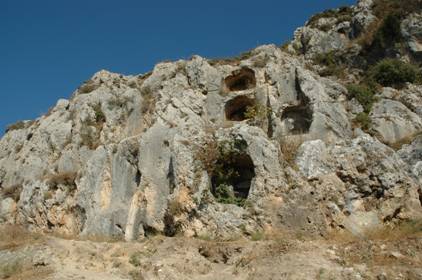
3. The grotto itself has all the characteristics of a sacred place with a spring which rises inside (in the right corner, though today it no longer flows). There are many examples. In a map of ancient Antioch in the area of the grotto of St. Peter and near the Charon carving, we find immediately the habitation of the drunken Dionysus.
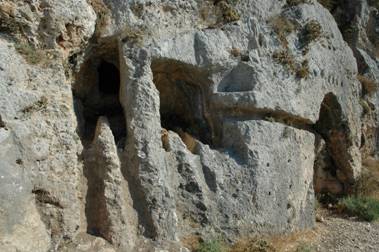
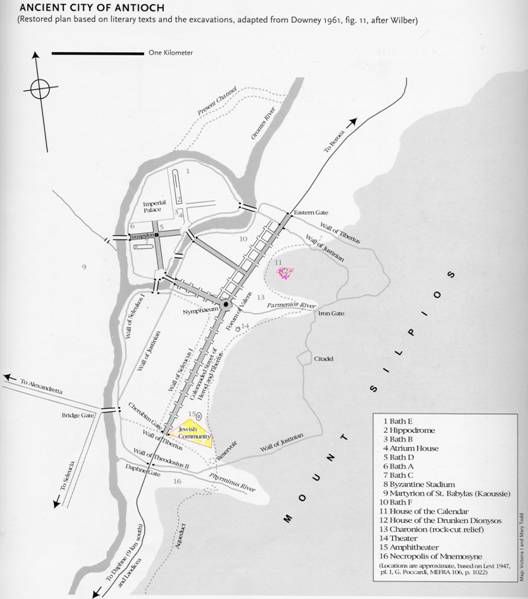
4. We know that the first believers in Jesus, being Jews, were in the habit of praying in the synagogue. Now the Jewish quarter was on the opposite side of the city near the Daphne Gate (see map above).
5. We also know that the first Christians, when they separated from the synagogue, met in private houses and not in special places far from their own environment.
6. Finally, in the first century it would have been impossible for the Christians, so called for the first time in Antioch, to have had a specific isolated place in which to meet, knowing that Christianity was prohibited by law, so they could easily have been discovered and arrested.
7. Luke himself, being a Levite, as was stated in the International Congress of 2000 at Padua (San Luca Ev. Testimone della fede che unisce vol. 1, p. 214), must have lived in the Jewish quarter of the city, near a synagogue, and it is very unlikely that he had private property in a sacred area of the city.
8. As often occurred after the freedom obtained from Constantine, the Christians transformed places of pagan worship into Christian ones. The same thing could have happened in this place. We know that in the past there was another place called the grotto of St Paul and this reminds us of the beginning of the evangelisation of this city.
9. On 8 February 380 Theodosius the Great promulgated the Edict 'De fide cattolica' (Of the Catholic Faith), which was addressed to all his subjects, imposing on them the symbol of Nicaea as a religious norm. Thus he became the true founder of the Catholic Church of the State. Probably after this, this pagan shrine was transformed into a place of Christian worship. History tells us that from 388 places of pagan worship, if not destroyed were converted to Christian worship 'baptising them' with other names. In our case, this grotto would take the name of an apostle. When this happened is nevertheless impossible to establish!
10. All this does not diminish the spiritual and historical value of the place; indeed, it helps to remind us of the beginning of Christianity in this city: moreover it is the only remnant in our past that can lead back to the fourth century of our era. Nevertheless it is not correct to say that the first Christians met with Paul, Peter, Barnabas, etc. in this place. This is only devout historical nostalgia!
11. The same carving of the probable Charon on the side of mountain makes us think that the place was sacred because this could have been carved in another place where it would have been more visible from the city.
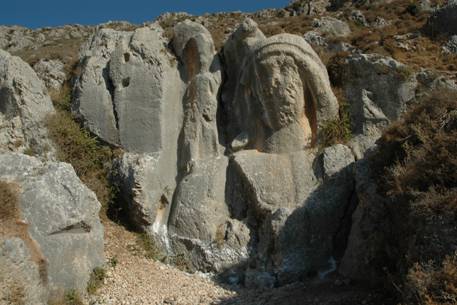
12. From the Christian writings of Antioch, in particular of St John Chrysostom, there is no mention at all of this particular place. I believe that this too is significant.
I believe that all this discussion helps us to define better the Christian origin of this rock-cut church, which continues to be called the first cathedral in the world on the grounds that St Peter presided over the Eucharist, as it is enacted today. But let us not forget that the Christian community then was very different from the present one and was still linked to the synagogue. Bir old picture:
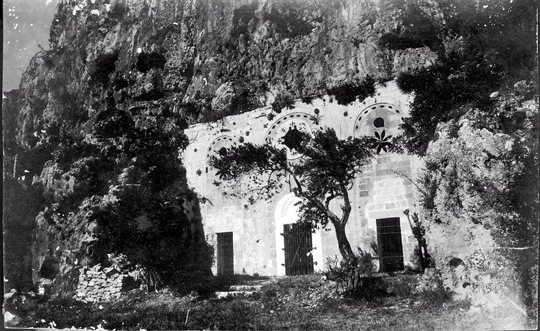
|



